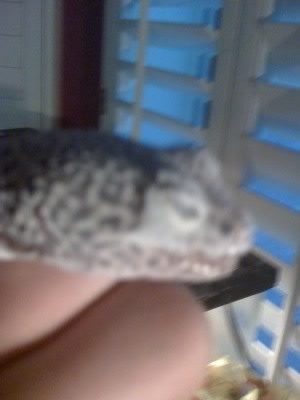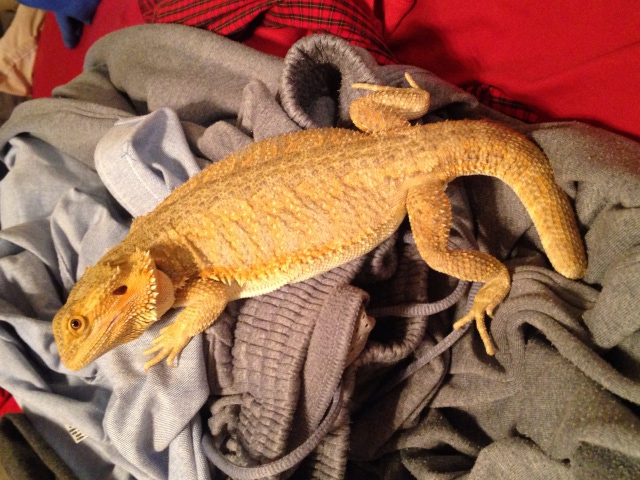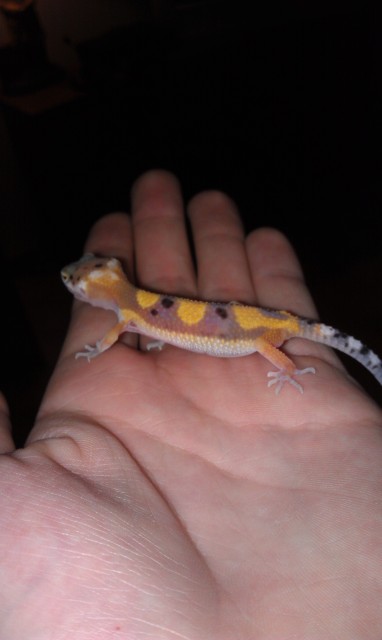QuestionQUESTION: I have a grey tree frog that adopted me about a year ago... he's living in a terrarium I set up for him. I feed him crickets (store-bought), house flies and small grasshoppers. This morning when I went to tidy up his cage, he was missing. The two grasshoppers I'd added the other day were still alive, so I began to worry that he might have gotten out. I removed all the items from the terrarium and finally found him buried in the substrate (expanded coconut fiber). He seems OK, soaked in the water pond for a bit to remove the fibers and has now returned to his usual spot up top on the tree bark.
So did I interrupt an attempt to hibernate?? This is his first year in the terrarium (I suspect he was in a house plant brought in last winter). Since it is still warm outside (I kept him inside first because it was winter then because it got so dry and hot), should I put him back outside or have I spoiled him by supplying him food? I actually enjoy watching him, but suspect that is being selfish.
Suggestions?
ANSWER: Hi Sherilyn,
I'm a bit confused about which species you have exactly. Grey tree frogs are not native to Alaska and are not listed as an introduced species either. There is an introduced population of Pacific Chorus frogs (also called Pacific tree frogs) near Ketchikan. This same species was found in Anchorage a few years ago, having come in on Christmas trees from Washington state. Residents were encouraged to kill the frogs to avoid disease introduction. That frog introduction did not result in an established breeding population but I wasn't able to determine whether any individual animals may have survived.
It is not uncommon for tree frogs to stowaway on shipped plants and end up far from home so you still may have a grey tree frog.
Releasing a non-native species is out of the question from an ethical standpoint so you can go on enjoying him in captivity without guilt!
I can't really comment on the hibernation like behaviour without knowing the species. As a general rule they will slow down as conditions become cooler and/or drier.
---------- FOLLOW-UP ----------
QUESTION: Thea, thank you for your reply. I am puzzled as to why you thought I was from Alaska... I live in east Central Texas and tree frogs are quite common here. If I missed a step in registering, I apologize.
AnswerHi Sherilyn,
Lol, Maybe there was a gremlin in the system that day but your original question came through with your location listed as "Alaska, United States"! I always make careful note of the questioner's location because it affects my answer. I get questions from all over the world, including the southern hemisphere where the seasons are opposite to ours. I remember thinking that yours was my first question from Alaska and even checked back again to verify and to see if you had listed a specific city.
You must have found my response quite odd to say the least!
Now that I know that you are from Texas, let me respond again to your question about releasing him.
Since he was only kept temporarily (rather then being raised) in captivity then his survival and hunting instincts will still be intact. Having been well-fed for this past year will give him an extra advantage for getting through the winter. It sounds like he was kept alone (ie. not with any other non-native frog species) so disease transmission to wild frog populations should not be an issue.
The usual argument against keeping wild-caught amphibians is that they often do not adjust to captivity but your little guy seems to have adjusted quite fine.
From a conservation standpoint they are not currently threatened so you don't need to feel guilty about that if you decide to keep him. The Gray's available in pet stores are most likely wild caught specimens as well.
As the days shorten and the temperatures drop he may become dormant for some periods and eat far less frequently. Captive reptiles/amphibians will often still follow seasonal hibernation cycles despite being in an artificial environment

 Bearded Dragon - Eye issue
QuestionStella 1
QUESTION: Hey,
I have a bearded
Bearded Dragon - Eye issue
QuestionStella 1
QUESTION: Hey,
I have a bearded
 UVB lights
QuestionBruces new VIV
QUESTION: I placed my 4 m
UVB lights
QuestionBruces new VIV
QUESTION: I placed my 4 m
 shed in my geckos eyes
Question
eye infection
i have two african fat tailed l
shed in my geckos eyes
Question
eye infection
i have two african fat tailed l
 Bearded Dragon - Tish
QuestionQUESTION: Hello. My bearded dragon is abo
Bearded Dragon - Tish
QuestionQUESTION: Hello. My bearded dragon is abo
 Vomiting Gecko
QuestionQUESTION: Hey Tracie,
Its Sean sorry I couldnt
Vomiting Gecko
QuestionQUESTION: Hey Tracie,
Its Sean sorry I couldnt